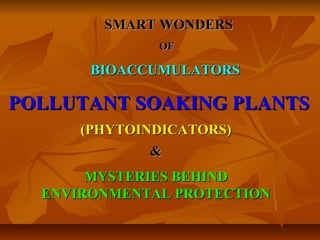
Small Wonder of BioAccumulators
- 1. SMART WONDERS OF BIOACCUMULATORS POLLUTANT SOAKING PLANTS (PHYTOINDICATORS) & MYSTERIES BEHIND ENVIRONMENTAL PROTECTION
- 2. Government College of Pharmacy Amravati-444604.(M.S.) INDIA. Nikam S.J*, Bhojane G.S. Yawale M.J., Raut R.R.
- 3. Objective :- reviewed enquiry of phytoindicators at molecular level as bioaccumulators for environmental protection role in pollution prevention with mechanism of action. why we save valuable plants from utter destruction ?
- 4. Why ? Topic -On both side of roads we see trees in series -Why certain trees like Peepal, Bel, Pakur, Bargad, Neem have been worshipped from times immemorial ?
- 5. Pollutant soaking plants -plants that have ability to assess levels of pollution. -serve as index of state of environmental of particular region. -Shows acute injury with externally visible symptoms in presence of high toxic pollutants. -indicative phenomena :- Bio-indication
- 6. Retains toxic pollutants/metabolic products of plant-pollutant interaction in their bodies Scavengers Pollution mitigator plants Bioaccumulators Phytoremediation
- 7. Symptoms Chlorosis (yellowing/whitening of green plants tissues due to ↓ chlorophyll) Necrosis (death of cells/tissues by disease ) Deformities of plants organs & ultimately death. Physiological changes Low photosynthetic activity Changes in cell sap pH & membrane permeability Low growth rate & crop yield Stimulation of respiration & irregularity in enzyme action.
- 8. Parameters to select good phytoindicators (in ecosystem) 1)Survival 2)Mortality 3)Pollutant uptake Efficiency varies with ecotypes b’coz diff. in geographical & climatic conditions. Ideal Properties of indicators:- Relatively easy to understand by non-scientists & other users. Sensitive to manageable human activity. Relatively tightly linked in space & time to that activity. Easily & accurately measured, with a low error rate.
- 9. How ? During uptake of essential nutrients through roots, absorbs metallic, non-metallic wastes, different toxic chemicals (PPCP), heavy metals (Cu ++,Zn++, Cd, Ag, Pb, Hg), inorganic biocides accumulated in stable plant parts (root/shoot) Phytoindicators Phytochelatins Metallothioneins sulphur containing polypeptides of low mol.wt. Designed by TheTemplateMart.com
- 10. Phytochelatins -group of proteins that inducible when they are faced with heavy metal stress. -Algae, Gymnosperms ,Monocots, Dicots Cd ++ -Cysteine, Glycine, Glutamic acid y-(GluCys)n-Gly conformation y-carboxylamide bond PCs r no direct result of expression of metal tolerance gene A product of biosynthetic pathway with glutathione ( detoxifying agent)
- 11. Ultra structure of Phytochelatins Fig.1-Phytochelatins bind to metal ions & transport oxidized metal to vacuoles for storage
- 12. Metallothioneins -similar proteins to PCs with high no. of cysteine molecules in proteins Characteristics low mol.wt. large fraction of cysteine residue Cu ++ -high metal content in metal- thiolate clusters
- 13. Ultra structure of Metallothioneins Fig.2-Metallothioneins bind metal ions for transport to deficient parts
- 14. Generalized Synthesis of Phytochelatins Heavy Metals e.g. Cd ++ + Plants Glutathione substrate Phytochelatin Synthase PCs (Phytochelatins) Continues untill all metals r complexed
- 15. Glutamine & Cysteine Cd ++ y-glutamylcysteine y-GluCys Glutathione synthase Vacuole Glutathione (GSH) + Cd ++ Phytochelatin synthase(Cad1) + PCs + Cd ++ Sulfides ↓ PC-Cd complexes ↑CdS -PC complexes
- 16. Air Purifiers/Pollutant Soaking Plants Peepal (Ficus rligiosa) Arjuna (Terminalia arjuna) Bel (Aegle marmelos) Makhan katori (Ficus krishnae) Neem (Azadirachta Kadam (Anthocephalus cadamba ) indica), Weeds Amaranthus graecizans Argemone mexicana Boerhaavia diffusa
- 17. Acknowledgement The authors expresses their sincere gratitude towards Respected Mr. Dinesh Gandhi Sir Mr. Rahul Akotkar Sir Mr. Vijay Waghulkar Sir for giving their valuable time for work.
- 18. References Dipanjan Ghosh: Science Reporter; NISCAIR, (CSIR), Vol. 43, No.6, June 2006. Cobbett CS: Phytochelatins and their roles in heavy metal detoxification. Plant Physiol 123: (2000) 825−832 Clemens S: Molecular mechanisms of plant metal tolerance and homeostasis. Planta(2001) 212: 475−486
